

Mami Odai, Art Producer, NPO S-AIR staff
S-AIR was launched in 1999 as an organization to run the first artist-in-residence (AIR) programs in Hokkaido. In July 2004, S-AIR was registered as a NPO (Non-Profit Organization); in 2008, it celebrated the 10th anniversary. For the past ten years S-AIR has invited 57 international artists from 27 countries to Sapporo.
Miracles of S-AIR or how AIR program started in Sapporo
Satoshi Hata, a Sapporo-based artist and currently a board member of S-AIR, was invited by Deutscher Akademischer Austauschdienst (DAAD) to experience an AIR program in Germany and came back to Japan in 1995. Hata told his friends that AIR programs were fruitful for artists and it had to be introduced to Sapporo. That triggered the launch of S-AIR. A friend of Hata, Kenichi Yamamoto was the chairperson of the executive committee and appealed to every channel he knew to realize an AIR program. Yamamoto commenced the project with Hisashi Shibata, the Chairman and Director of S-AIR today. Back then, Japan was at the dawn of AIR programs, so people viewed programs in Europe and the U.S. as role models and tried to figure out the meaning of such programs in Japan. From the very beginning of S-AIR, Yamamoto assessed that AIR programs had the potential to lead a meaningful relationship between art activities and the society by contributing to revitalization of a city. His clear vision of S-AIR activities had been the only guiding light for the past ten years.
Organizers started S-AIR program without any operational skill or guidance. The executive committee and citizen volunteers supported the two-person administration office. They kept in mind: “What is the best support for artists?” and started operation with trials and errors. S-AIR supports its artist-in-residence program to realize what the artist wants to do as best they can. This attitude is best described by Shibata’s groundless and yet confident statement: “If we follow the artists’ true intentions, we can’t be wrong.”
S-AIR came to known as the international program organizer because it started calling for applications and doing public relations via the Internet at its early stage. Takashi Honma was in the administration office with Shibata, mainly in charge of communication in English and website design. Honma was excellent at IT skills; or rather he should be called as “Mac-otaku (a man with obsessive interest in Apple’s Macintosh computers).” His expertise was a great contribution to the program. It was a miracle that S-AIR happened to have talents and expertise required for operation within its minimum manpower.
With no greatest ambition as an AIR organizer nor with decent salary -sorry to say that-, how could they keep struggling for ten years to work on the activity just because they thought it was fun? It was a true miracle of people, the environment, and the City of Sapporo that supported this small organization.
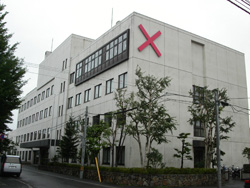
Inter Cross Creative Centre (ICC)
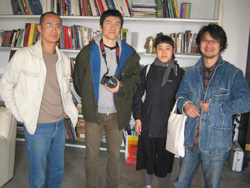
S-AIR staff
Leaving to chance: characteristics and progress of S-AIR program
In 2002 I joined the operation of S-AIR. At that time, S-AIR didn’t care nor be pretentious that it was a unique organization with great potentials in Sapporo. Such atmosphere of freedom persuaded me to join the S-AIR program and let me launch new projects (Art Akebono, Artist in School, and Sapporo II Project) to enhance the acknowledgement of AIR programs. The atmosphere implied, “You can try anything you want.” Without this implication, I could never keep working in S-AIR. Thanks to this environment, I could launch projects that mattered to me.
A distinctive feature of S-AIR program is that it owns no facility. For creative activities, S-AIR uses vacant spaces in Inter Cross Creative Centre (ICC) where young entrepreneurs have their offices. ICC became a program partner of S-AIR. Every time it hosts exhibitions and presentations, S-AIR rents a gallery, alternative space, or shop in Sapporo city. With no facility of its own, S-AIR has to connect to other organizations and people to work with. Another benefit is its flexibility to coordinate the venue depending on the opinions or interest of the administration office at the particular time and of course on the needs and concepts of the artist in residence. At the beginning, S-AIR program aimed at providing artists with the environment for creative productions, the style typically found in programs in Europe and the U.S. In ten years, however, it had undergone gradual changes due to the changes in support of AIR programs in Japan. By repeating spontaneous coordination with other organizations and sites, S-AIR gradually transformed itself into a program closely connected to the community of Sapporo. In other words, we have changed without noticing while keeping ourselves busy in dealing with activities day by day.

Resident artist Ms. Julia Lohmann
Need to escape boredom: a local city and AIR
At the launch, the executive committee and supporters of S-AIR consisted many citizens and artists living in Sapporo. They seemed to join the project in order to dissolve a feeling of cooped-up that is inevitable in a not-so-large community. In addition, Sapporo, as a local city, has always welcomed people from the outside. I myself was also a guest from outside Hokkaido, just like residents who stay in Sapporo for a short term under AIR program. Sapporo, the host of guests, has both compelling hunger for information from the outside and hospitality that the city acquired as a tourist city. AIR is an art program in which the city’s hospitality is fully demonstrated. In other words, AIR has excellent chemistry with the city of Sapporo and the spirit of its citizens.
I’m not sure whether different points of view, presentation, or concepts of artworks provided by resident artists have any impact on local art. I do believe, though, that despite of language barriers, resident artists’ communication skill, energy, and travel distance have persuasive influence on the activities of local artists. Once the artists determine to make Sapporo their base of activity, they hardly move from their local community. S-AIR helps them to be motivated to participate in AIR programs abroad if they have meanings and opportunities to move temporary to different countries to work as artists in order to stay in active in their local community.
I believe the meaning of AIR programs located in local cities should be found in their influences on local artists to be motivated. These programs should let the artists realize that there is such a program and an opportunity is ready for them, so they can give it a try for change of pace.
It is true that immobility can produce culture, thoughts, and ideas. On the other hand, mobility can produce dynamism, speed, and even blur that can be effective in some cases. It seems to me that alternatives can encourage people to make up their minds and to hold on to their decisions.
With such belief, we started S-AIR AWARD three years ago to send local artists to overseas organizations with support by the City of Sapporo. Two artists per year have been sent.
S-AIR Hot spring: Life of a resident artist and afterward
We are glad to hear that most of resident artists feel close to people involved in S-AIR just like their families. Short trips, meals, visits to hot springs with residents are fun to S-AIR staff as well. Each artist participates in an AIR program with different motives and goals, so we are not sure whether S-AIR’s such attitude has been good for every resident in the program. Some artists escaped from their places of activity where they feel personal deadlock, and their place of stay happened to be S-AIR in Sapporo. These artists show fierce concentration on their production. Some other artists said that they could hardly find anything stimulating in Sapporo so they had no other choice but to concentrate on their productions. As a result, they could create artworks that were completely different from those they had made before, and they could also verify their ability to concentrate on their production. At any rate, the experience of being in a foreign place with foreign people to force themselves to show their results can significantly contribute to their career. The toughness and strength of artists are extraordinary. After they completed their residence in S-AIR, many of these artists broaden their stages of activity internationally and become acclaimed artists than ever. This can be one of S-AIR’s achievements by providing “nothingness” for artists who produce their artworks from nothing.
Snow keeps falling: our new winter programs
In search of more fun, S-AIR starts seriously dealing with projects in winter. At S-AIR, board members and local artists are discussing how to convert heavy snowfall in Sapporo into local resource; residents and guest artists asked why S-AIR has no project of utilizing winter or snowfall; and there are business offers. Interest of S-AIR is now targeting at winter and snowfall.
Sapporo is a large city with annual snowfall that can accumulate to approximately 6 meters. We can’t miss this extraordinary beautiful, unique, and most significant feature of the city. Art should lead an activity to handle snowfall as local resource, to be a city with ecological awareness, and to foster this new awareness. The project of winter and snowfall will seek cooperation among local artists, educational institutions, and other cultural facilities. In the end, this project will appeal to the awareness of citizens and revitalize the city, and, as a result, it can be developed as a real community project.
After all, Sapporo is in winter for half year, and people have to live with snowfall for whole four months. The spirit of people in Hokkaido can’t be explained without the winter. The ongoing project “Artist in School” started in 2003 places much value on being held in winter. (Since 2007, Artist in School project has been planned and organized by AIS Planning (CEO: Takahiro Urushi).)
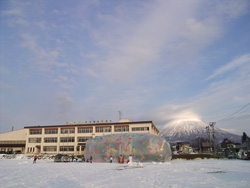

Artist in School
There are two other winter projects that S-AIR has been planning or organizing up to 2008.
One of these projects is already in its fifth round: an exhibition called “Snowscape Moere” held at Moerenuma Park designed by Isamu Noguchi (organized by Shibata and the committee for this project). This project has been at the center of attention as an event to present new snow scenery of Moerenuma Park in winter.
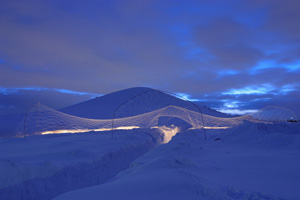
Snowscape Moere
The other project is based on a concept presented in Snowscape Moere; a project led by artists called “Sapporo II Project” (I’m one of the founders). This project places value on the process: in other words, it aims at encouraging artists to be motivated as “There is the snow, so let’s create something.” This is not a transient project like Sapporo Snow Festival in which the purpose is what kind of artwork you can make with the snow. It is more than temporary engagement with the snow: we are making this project to live with the destiny of Sapporo, a big city that can’t escape from the snow. Therefore, we collaborate with snow removal activity and aim at preparing the environment to establish the project in immediate proximity of people living in this city. Here, Artist in Residence program is requisite for this project. We are planning to establish an independent governing body to give further impetus to the project. Prospective partners are: educational institutions, teachers study groups, a section in the local government in charge of snow removal, public institutions such as Sapporo Museum Activity Center, snow festivals and events organized by local communities.
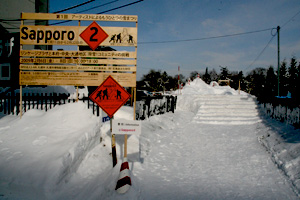
Another Snow Festival
Starting in 2009, we attempt to coordinate the existing winter projects. Each program maintains its originality while collaborating with each other to create new multifaceted winter projects.
Next decade: Fostering next generation and handover
What an AIR program operation can provide is not only support for residents participating in the AIR program but also opportunities for artists in the local community to train their management skills and perspectives. There are only few management personnel in the field of art, so artists themselves have to make their own places for activities.
In my honest opinion as a person who has involved in many art projects, artists tend to have biased and self-originated perspectives. If it works well, the project becomes worthwhile and leads to inexhaustible creativity. On the other hand, if it doesn’t work, the project becomes self-righteous and the artist is unable to gain wide support or sympathy, resulting in self-destructive position at the edge of the society.
To avoid such tragedy, I believe an artist should have a management perspective that can evaluate things with multiple perspectives, not an artistic perspective that relies solely on his or her own sensibility.
In Sapporo there had been activities let by artists to jointly organize large-scale exhibitions. In a joint exhibition, however, competitiveness among artists is inevitable, so the management skill cannot be trained. Such exhibition merely fosters “friendship” or “cooperation.” Such friendship and cooperation can often results in lack in rigor that is required to improve the quality of art. If it is a business activity, artists have to devote their knowledge and energy to others’ sake, not to their own benefit.
The administration office of S-AIR now has staff of new generation and its operation has been refreshed. When local young artists can devote their time and efforts to support resident artists with honesty and respect, they can acquire objective perspectives. A variety of management jobs in AIR project can enhance experiences of the staff and be optimal to be skilled managers.
S-AIR is also a voluntary and non-profit organization established by artists and people involved in arts. Over ten years, a brand-new organization has made its own history. As resident artists come and go in several-month intervals, the administration staff also changes from time to time. I hope S-AIR will grow as a unique but open-to-public organization.
It seems to me that the profile of art in the society is still low; by stating this I reproach myself. As time has passed and the next generation is about to emerge, every presumption becomes blur today. People have been proclaiming impudently that anything goes in art; now they have to pay for it. This is payback for the fact that people in art have been demanding the society to communicate with them but indeed they refused to communicate. Arts and activities that had chosen to be spoiled by the society will be extinct when they realize that the society is not mature enough to rely on.
It’s been ten years since a miracle happened that people involved in art around the same time in Sapporo voluntarily started S-AIR without prefixed arrangement by the bureaucrats. Now S-AIR has to return the favor that has been given by the society. With a decade of history, S-AIR becomes a matured organization with responsibilities. The objective of S-AIR for the eleventh year and years to come is to collaborate in earnest with the local government and community while keeping its flexibility.
A tough objective will influence on my own activities. The ten years to come will be a critical period.
Now I have to brace myself for this fight!
Mami Odai: As a program manager of S-AIR, she was in charge of Artist in School project. Currently she is studying at TransArtists in Holland, a cultural organization which provides information on artist-in-residence opportunities around the world.
[June 1, 2009]
2024.7.9Acasă la Hundorf Residency JournalArtist : Miyake Suzuko
2023.5.14AIR and I, 09 : Mentoring Artists for Women’s Art (MAWA) Residence Report